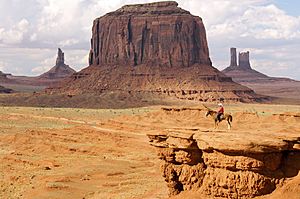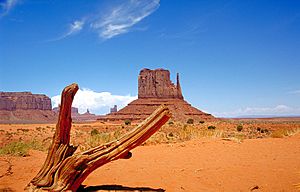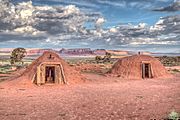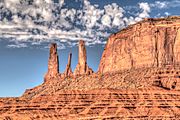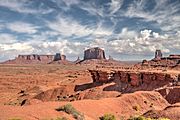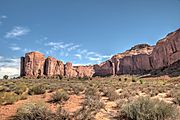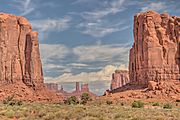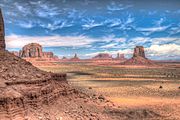Monument Valley facts for kids
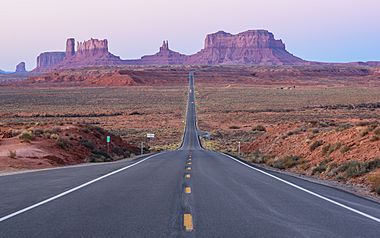
Monument Valley (Navajo: Tsé Biiʼ Ndzisgaii meaning valley of the rocks) is a famous area on the Colorado Plateau. It is known for its huge sandstone buttes, which are tall, flat-topped hills. Some of these buttes rise 1,000 ft (300 m) above the valley floor!
This amazing place is located right on the border between Arizona and Utah (around 36°59′N 110°6′W / 36.983°N 110.100°W). It is close to the Four Corners area, where Arizona, Utah, Colorado, and New Mexico meet. Monument Valley is part of the Navajo Nation Reservation and you can reach it by U.S. Highway 163.
Many movies, TV shows, and video games have featured Monument Valley since the 1930s. The famous director John Ford filmed many of his well-known Western movies here. Because of this, Monument Valley has helped shape how people imagine the American West.
Contents
Geography and Geology of Monument Valley
Monument Valley is part of the Colorado Plateau, which is a large, high desert area. The valley floor is about 5,000 to 6,000 feet (1,500 to 1,800 m) above sea level. The ground is mostly made of soft rock called siltstone or sand from it. This material was left behind by ancient rivers that carved out the valley.
The valley's bright red color comes from iron oxide, which is like rust, found in the siltstone. The darker, blue-gray rocks get their color from manganese oxide.
The tall buttes clearly show different layers of rock. There are three main layers you can see. The bottom layer is called the Organ Rock Shale. Above that is the de Chelly Sandstone. The very top layer is the Moenkopi Formation, which is covered by a harder rock called Shinarump Conglomerate. You can also find large stone formations here, like the famous "Eye of the Sun."
Visiting Monument Valley
Monument Valley is a large region. The main part that visitors explore is called the Monument Valley Navajo Tribal Park. This park is like a national park, but it is managed by the Navajo Nation. The town of Oljato is also part of the wider Monument Valley area.
Visitors can pay a fee to enter the park. Once inside, you can drive a 17-mile (27 km) dirt road through the park. This drive usually takes about 2 to 3 hours. Some parts of Monument Valley, like Mystery Valley and Hunts Mesa, can only be explored with a guided tour.
Climate in Monument Valley
Monument Valley has a desert climate. This means it has cold winters and hot summers. Even though summers can be hot, the high elevation of the valley helps to make the heat more bearable.
Summer temperatures usually stay below 100 °F (38 °C). Summer nights are cool, with temperatures dropping quickly after the sun sets. Winters are cold, but daytime temperatures are usually above freezing. It can snow a little in winter, but the snow usually melts within a day or two.
Gallery
Panoramas
Other images
Monument Valley in Movies and Media
Monument Valley has been a popular filming location for many years. It has appeared in computer games, books, and especially in movies.
The director John Ford used Monument Valley in many of his famous Western films. These movies helped shape how people around the world imagined the American West. Some of his films shot here include:
- Stagecoach (1939)
- My Darling Clementine (1946)
- Fort Apache (1948)
- She Wore a Yellow Ribbon (1949)
- The Searchers (1956)
More recently, other directors have also filmed movies in Monument Valley. These include Sergio Leone's Once Upon a Time in the West (1967), which was the first Spaghetti Western filmed outside of Europe. Also, Gore Verbinski's The Lone Ranger was filmed here.
See also
 In Spanish: Valle de los Monumentos para niños
In Spanish: Valle de los Monumentos para niños




